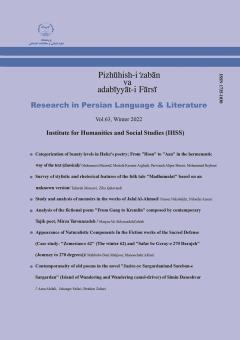-
-
List of Articles
-
Open Access Article
1 - Categorization of beauty levels in Hafez's poetry; From "Hosn" to "Aan" in the hermeneutic way of the text (classical)
Gholamreza Maroof Mostafa Kazemi Azghadi paevane alipour shirazi Mohammad reihani -
Open Access Article
2 - Survey of stylistic and rhetorical features of the folk tale "Madhumalat" based on an unknown version
tahere mousavi Ziba Ghalavandi -
Open Access Article
3 - Study and analysis of memoirs in the works of Jalal Al-Ahmad
Nasser Nikobakht Niloufar Ansari -
Open Access Article
4 - Analysis of the fictional poem "From Gang to Kremlin" composed by contemporary Tajik poet, Mirza Tursunzadeh
Marjan Ali AkbarzadehZohtab -
Open Access Article
5 - Appearance of Naturalistic Components In the Fiction works of the Sacred Defense (Case study: "Zemestan-e 62" (The winter 62) and "Safar be Geray-e 270 Darajeh" (Journey to 270 degrees))
Mahboubeh Banimahjour manouchehr akbari -
Open Access Article
6 - Contemporaneity of old poems in the novel "Jazire-ye Sargardani and Sareban-e Sargardan" (Island of Wandering and Wandering camel-driver) of Simin Daneshvar
asena abdali Jahangir safari ebrahim zaheri abdevand
-
The rights to this website are owned by the Raimag Press Management System.
Copyright © 2017-2026







